Protactinium 50mm Lucite Cube
Protactinium 50mm Lucite Cube
Almost two years to the date after listing our first 50mm acrylic cube on this site (and Amazon) we have scored what will likely be our last element: protactinium.
This obscure element is so rare in nature that its existence was verified only 99 years ago and it wouldn't be until the 1930's that a few milligrams of the free metal was finally able to be extracted. Then in 1961 the Brits rolled up their sleeves and specifically commissioned a team of nuclear physicists to extract as much of this metal as possible from 60 tons of spent nuclear fuel - an abnormally rich source of Pa-231. For their efforts they were rewarded with a sum total of 125 grams (4 ounces) at a cost of $4,000/g. Years later the USA came in with some cutthroat pricing from its lab in Oak Ridge, TN at the bargain rate of just $280/g. But don't bother shopping for it on their site without the necessary permits. A gram of this radioactive element would kill you dead within hours anyway and your corpse declared a superfund toxic site.
Luckily, the hobbyist is left with the alternative of undertaking their own project in extraction and purification following the same methods that worked for the Curies. You start with high grade uranium ore off of eBay (keywords: uraninite, pitchblende) and then pulverize the living hell out of this rock until the consistency of very fine powder. Of course, this being radioactive dust the whole operation will make this laborious process a very unwholesome one as well without the aid of a full hazmat suit or at least a decent sized glove box. At an average concentration of one part in ten million, you could expect to get a milligram or so of Pa-231 from a twenty pound rock of high grade uraninite.
The process to separate the Pa-231 involves taking the finely powdered uraninite and boiling it in nitric acid to remove the uranium and thorium present. The residue is then treated to heating with hydrofluoric acid over a period of several days. Next, it is subjected to a solvent with the catchy name diisobutyl ketone and then more rounds submerged in nitric acid. The end result after all this work is a thin plating deposited on aluminum that contains a microscopic quantity of protactinium metal.
And here we have it, a gloriously active quantity rendering some 1,600 decays per second, or 0.045 μCi! Confirmation of the success of the experiment is here shown on the second photograph with the spectroscopic spike signature unique to protactinium.
Any way you put it this is a tremendously rare opportunity for the advanced collector to obtain an infinitesimally small but verifiable concentrated quantity of one of nature's rarest atoms. The strip resides in an ampule which is permanently sealed inside a 50x50x50mm block of optical clarity acrylic which should last long enough to see the little protactinium sample through its first 32,700 year half life :-)



